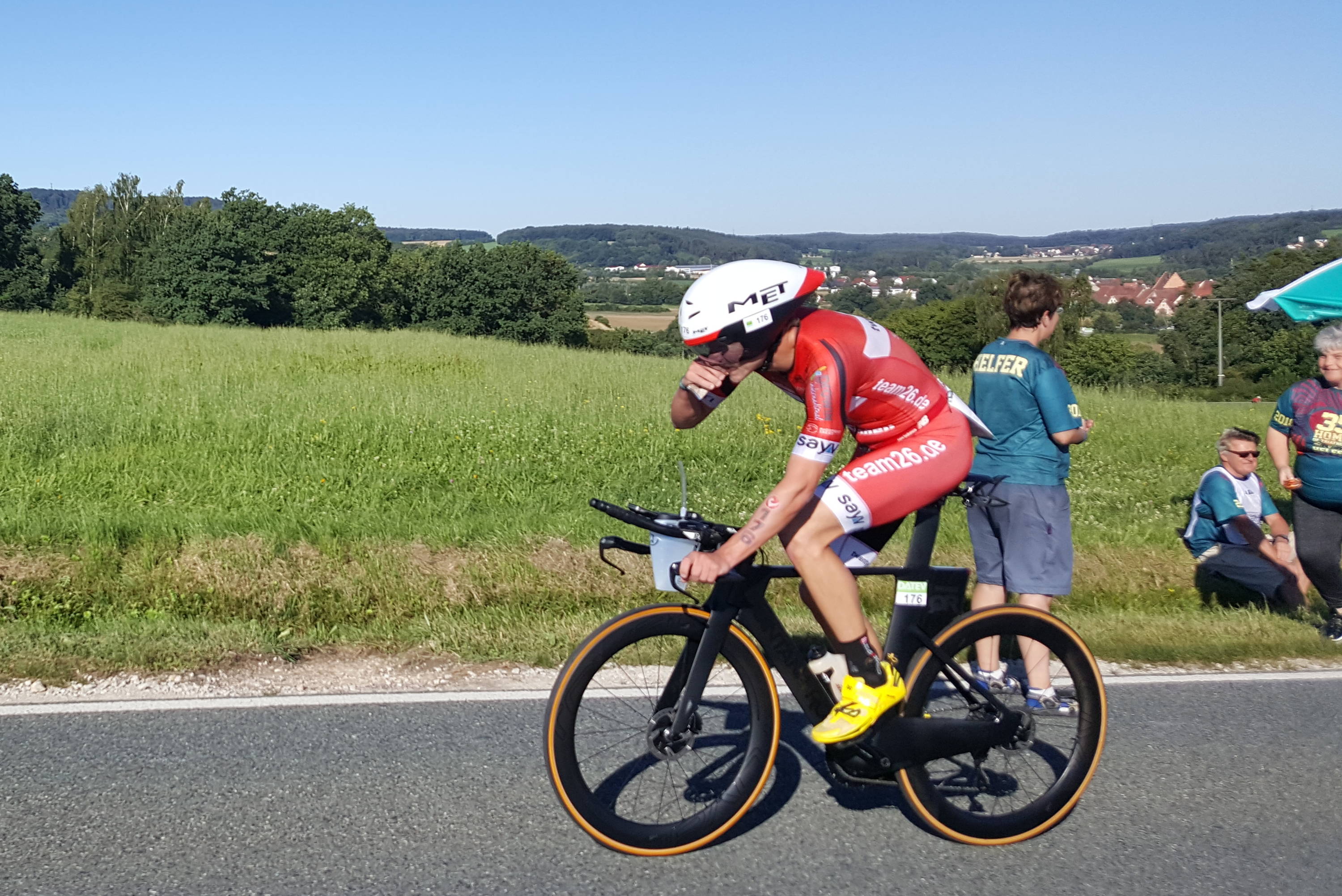Especially for medium and long distances, the ability to continuously provide energy is a performance-limiting factor. At the same time it is THE key to success! With a spiroergometry, the metabolism is measured during physical exertion. This diagnostic procedure creates a current performance picture from which both individual training areas and an immediate competition strategy can be derived.
In contrast to the short competition formats, middle and long-distance triathlons are characterized by a load structure in the submaximal intensity range. This should be maintained as evenly as possible over a long period of time without a drop in performance. The long-lasting aerobic supply of the working muscles is of decisive importance for successful competition performance.
A calculation example:
An athlete burns about 1,000 kcal/h at high intensity. Due to the high pace of the competition, the entire energy requirement is generated from KH. Well filled glycogen stores provide a total amount of energy of approx. 2,000 kcal/h, which is sufficient for approx. 2 hours of competition. In addition, the athlete takes bars and gels. However, the gastric absorption capacity is limited under physical exertion and is around 60-100 g KH/hour. This corresponds to an amount of energy of approx. 300-400 kcal/h. Maximum! In total, the supplied and endogenous reserves are therefore used up after 3 hours, the "man with the hammer" comes. Loss of energy, lack of energy, drop in performance. A killer over the long haul!
What is happening in the body?
Carbohydrates (KH) and fats (F) are the body's main sources of energy and are burned in the muscle cells. The energy released enables muscular work. For the long lasting
However, endurance performance is decisive in which ratio the energy sources are used, because KH and F differ fundamentally in the type of energy conversion. The intensity of the load has a decisive influence on which store the body uses:
Fats are stored in the body as complex chains of molecules and are available in almost unlimited quantities. Energy is generated relatively slowly and exclusively aerobically (with oxygen). Therefore, fatty acids are mainly converted at a low to medium load level. In theory, the amount of energy available is sufficient for several Ironman distances in a row.
The faster and more intense the exercise intensity, the less fat can be metabolized. Instead, the proportion of carbohydrates increases . These offer the possibility of rapid energy supply and deliver a high energy potential up to the highest intensity ranges. The problem: the stores stored in the body are very limited. After about 90 minutes of intensive use, the memory is empty. The significant depletion of energy reserves can be delayed a little by eating (bars/gels/bananas, etc.), but by no means compensated for. The result: starvation, drop in performance. A constant performance of more than 3 hours at the intensity level of pure KH conversion is therefore not possible.
Conclusion:
- The right "energy mix" (proportion of KH to F) leads to long-lasting performance in the race
- The right competition intensity leads to optimal performance
- The right training prepares the body for the competition situation
Spiroergometry (Aeroscan)
Performance-relevant parameters (energy consumption, oxygen uptake, relative F/KH metabolism) can be determined directly with the help of spiroergometric performance diagnostics. The following conclusions can be drawn from this:
- Competition strategy: Based on the values, a targeted determination of the individual competition intensity (performance values / pace / heart rate) and the associated nutrition strategy can be made.
- Training zones: the values achieved reflect the current level of performance of the athlete. From this, the need for action for further training can be determined and implemented in concrete training measures. The training areas (basic/advanced/development/competition areas) are clearly defined.
How does it work?
In the context of spiroergometry (Aeroscan), the respiratory gases of an athlete are measured in a step test procedure. These provide information about the energy metabolism: the respiratory quotient (RQ) results from the ratio of carbon dioxide release to oxygen intake. With pure fat burning (RQ=0.7), the proportion of consumed O2 predominates due to the biochemical processes in the muscle cell. With increasing stress intensity, the proportion of carbohydrates in the energy supply increases continuously, and the RQ value also increases. At RQ=1.0 only carbohydrates are metabolized. The later this point is reached, the better the individual training condition. This threshold value is then the starting point for determining the training areas and the competition forecast. If the step test is continued up to the point of exhaustion, the RQ even rises to values above 1.0 - in this case carbohydrates are then metabolized anaerobically, lactate is formed. However, lactate measurements are less relevant as a performance forecast for middle and long distances: anaerobic capacity and lactate tolerance play an insignificant role over long competition distances.
Conclusion
With a spiroergometry, the metabolism is measured during physical exertion. As a key competence for middle and long-distance athletes, this diagnostic procedure creates an up-to-date performance picture from which both targeted training priorities and an individual competition strategy can be derived.
By the way: Professionals regularly carry out performance diagnostic test procedures in order to be able to optimally control their training in each training period and to be able to use the current performance values for the race. The same principles of training science also apply to non-professionals...
Discover the huge trisuit collection
From the basic one-piece suit to the high-end aerosuit




















